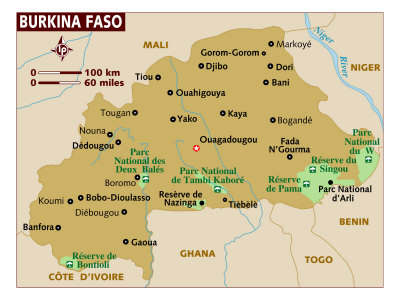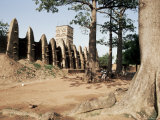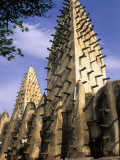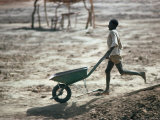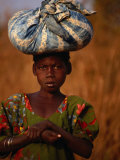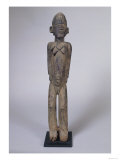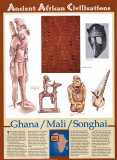|
|
|
|
|
|
|
|
|
|
|
|
BOOKS ABOUT AFRICA & BURKINA FASO
|
|
|
|
|
|
|
|
|
|
|
|
|
|
|
|
 |
|
|
|
|
|
Burkina Faso Posters, Prints, Charts, Maps
for social studies classrooms and homeschoolers.
|
geography > Africa > BURKINA FASO < social studies
|
Burkina Faso is a small landlocked country in Western Africa, north of Ghana and bordered by Benin, Cote d'Ivoire, Mali, Niger, and Togo. Formerly known as Upper Volta, Burkina Faso achieved independence from France in 1960.
Plagued by recurring droughts, desertification, overgrazing, soil degradation and deforestation, Burkina Faso is one of the poorest countries in the world with few natural resources and a weak industrial base with most (90%) of the population engaged in subsistence agriculture.
|
|
|
Ouagadougou, the capital and largest city of Burkina Faso, was the site of one of the largest markets in West Africa, which burned in 2003 and remains closed.
|
|
|
|
Religion, according to Wikipedia a popular saying in Burkina Faso, “claims that ‘50% are Muslim, 50% are Christian, and 100% are animist’. The Great Mosque of Bobo-Dioulasso, the second largest city in Burkina Faso, was built by people of different faiths working together.”
|
|
|
|
|
|
| Did you know the word guinguette is French? Dictionnaire de la langue français (1750): "Small cabaret in the suburbs and the surrounds of Paris, where craftsmen drink in the summer and on Sundays and on Festival days." • more women posters |
|
|
|
The Lobi are an ethnic group that originated in what is today Ghana. Starting around 1770 many of the Lobi migrated into Burkina Faso and later into Côte d'Ivoire.
The Lobi carve many types of objects, ranging from every day items to figures that embody religious ideals. The “bateba” are recognized as living beings, which are placed on the shrines of “thila” and are able to communicate with one another and to fight off witches. [Art and Life in Africa]
|
|
|
|
Ghana, Mali, Songhai-
Taken together, Ghana, Mali, and Songhai controlled most of western Africa for nearly 1,000 years. All three empires were fabulously wealthy and powerful, and their influence can still be felt in the culture and arts and sciences of modern West Africa. The civilization of Ghana was established during the 5th and 6th centuries C.E. This hightly structured empire, which spread over the countries now known as Mauritania, Senegal, and Mali, was fueled by the huge gold reserves in the southern savanna lands. Visitors to Ghana were shocked to see how much gold the king (called “Ghana”) displayed in his royal palace – even the horses and dogs wore gold collars. Important trade routes helped Ghanan merchants to sell their ware all over Africa. But all the gold in Ghana could not save the empire when a group of Berber Muslims known as the Almoravids, invaded in 1076 and burned the capital.
After several centuries of fighting to control the trade routes, the Mandinka prince Sundiata Keita rose to power in the year 1233 and established the empire of Mali. This civilization, which lasted for more than 300 years, incorporated all the trade routes and land west of the Niger River as well as the gold reserves of the south. Timbuktu became the capital and soon earned a reputation as one of the most worldly cities in Africa, as well as one of the richest in the world. Arts and education flourished in the Islamic universities of Timbuktu. Malian sculpture became famous for its strong shapes. Musical storytellers called griots were the royal musicians, and the sound of a guitar-like instruments called the kora was soon heard all over western Africa.
But Mali began to weaken in the 1400s, when the empire became too big to manage. The Songhai people rose to power in 1464, under the leadership of Sonni Ber Ali, who eventually conqured Timbuktu and the leading city of Jenne. Ali and his successors ruled over the Songhai empire for more than 100 years, until it fell to Moroccan invaders.
While no great empire rose up to replace Songhai, the traditions of all three civilizations live on in the art, music, and traditions of modern Africa – and in the vibrant and sophisticated city of Timbuktu.
The Songhai Empire succeeded the declining Mali Empire and from the early 15th to the late 16th century was one of the largest African empires in history. The Songhai Empire was centered in eastern Mali and stretched through parts of present day Niger, Nigeria, Burkina Faso, Benin, Ghana, Senegal, Mauritania, and Guinea.
The first great king of Songhai was Sunni Ali, a Muslim like the Mali kings before him, who had derived great wealth through trade with Arabs. The Songhai Empire continued to be a strong trading economy with the goldfields of the Niger River a primary resource of the Songhai Empire. Gold was sometimes traded one to one for precious salt, a primary ingredient in food preservation.
• more Ancient African Civilizations posters
|
|
|
|
|
|
|
|
|
previous page | top
|
|
I have searched the web for visual, text, and manipulative curriculum support materials - teaching posters, art prints, maps, charts, calendars, books and educational toys featuring famous people, places and events - to help teachers optimize their valuable time and budget.
Browsing the subject areas at NetPosterWorks.com is a learning experience where educators can plan context rich environments while comparing prices, special discounts, framing options and shipping from educational resources.
Thank you for starting your search for inspirational, motivational, and educational posters and learning materials at NetPosterWorks.com. If you need help please contact us.
|
|
|









